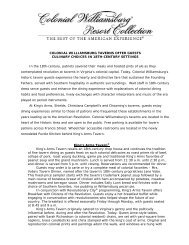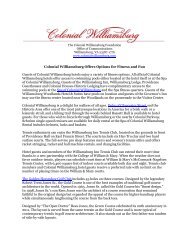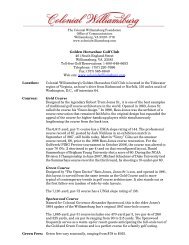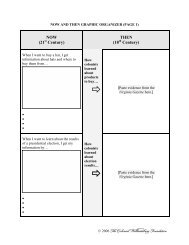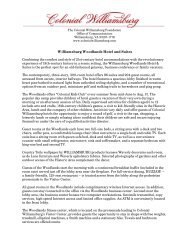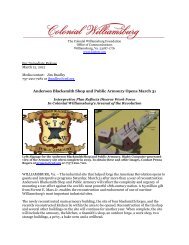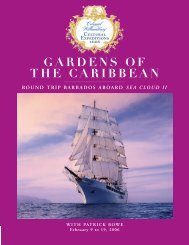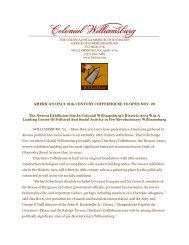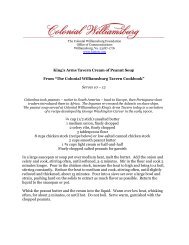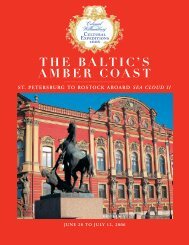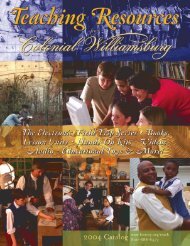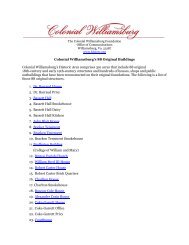Colonial Williamsburg's Coaches For more than 50 years, Colonial ...
Colonial Williamsburg's Coaches For more than 50 years, Colonial ...
Colonial Williamsburg's Coaches For more than 50 years, Colonial ...
You also want an ePaper? Increase the reach of your titles
YUMPU automatically turns print PDFs into web optimized ePapers that Google loves.
<strong>Colonial</strong> Williamsburg <strong>Coaches</strong> – PAGE 2<br />
<br />
<br />
<br />
<br />
The Landau. The Foundation’s VIP coach, the Landau, was constructed by <strong>Colonial</strong><br />
Williamsburg personnel with the assistance of carriage authority Paul Downing in 1960.<br />
Named for the German town from which they originated, Landau carriages were in use<br />
in England by the mid-18th century. Felton described them as “built in the manner of a<br />
coach but with the upper part of the body to open at pleasure.” There was at least one<br />
Landau in colonial Virginia; the 1775-76 inventory of Philip Ludwell Lee of Stratford in<br />
West<strong>more</strong>land County lists such a vehicle. <strong>For</strong> this reason, <strong>Colonial</strong> Williamsburg’s<br />
Landau is emblazoned with the Lee family coat-of-arms, whose Latin motto reads, “Ne<br />
incautus future” (“Not heedless of the future”). It is used primarily for special events and<br />
visiting heads-of-state. Notable passengers have included Richard Nixon, King Hussein<br />
of Jordan, Emperor Hirohito and Empress Nagako of Japan, Lady Bird Johnson, Ronald<br />
Reagan, King Harald and Queen Sonja of Norway, United Nations Secretary General<br />
Koffi Annan and Queen Elizabeth II of England, as well as past prime ministers of<br />
Greece, Turkey, Malaysia, India, Taiwan, Denmark, Italy, Pakistan, Tunisia, Ireland,<br />
Canada and Japan.<br />
The Robert Carter Coach. In 2001 work began on <strong>Colonial</strong> Williamsburg’s first new<br />
coach in four decades, made possible through the generosity of Maureen and Jim<br />
Gorman. Completed the following year by Florian Staudner of Vienna, Austria, it is based<br />
on an 18th-century English traveling coach in the ownership of Andre Becker of<br />
Coisigners, France. The coach takes its name from an 18th-century member of<br />
Williamsburg’s gentry, who in 1773 ordered “a strong, fashionable coach without a box,<br />
no guilding thereon, but neatly painted and varnished, the body to be lined with blue<br />
leather.” Carter’s coach was built in London by Joseph Jacobs Jr. for a then-exorbitant<br />
£119. In his honor, today’s Robert Carter Coach bears his family’s coat-of-arms, which<br />
includes the Latin motto, “Purus Sceleris” (“Pure in regards to wickedness or crime”).<br />
The Royal Governor’s Coach. Upon completion of the Robert Carter Coach,<br />
Staudner set to work on the newest addition to <strong>Colonial</strong> Williamsburg’s carriage fleet,<br />
once again through the generosity of Mr. and Mrs. Gorman. Completed in 2005, it is an<br />
exact replica of an 18th-century coach in the keeping of the Museum of the Palazzo<br />
Farnese in Piacenza, Italy. Unique among the Foundation’s carriages, this luxurious<br />
enclosed town coach would have been a mark of wealth and prestige in colonial America.<br />
Just such a vehicle was built for Williamsburg’s last royal governor, Lord Dun<strong>more</strong>, by<br />
Elkanah Deane, who in 1773 wrote, “I made, in the city of New York, for his Excellency<br />
the Right Honorable Earl of Dun<strong>more</strong>, a coach, phaeton, and a chaise, which may now be<br />
seen by any gentleman that has an inclination.” Today, Lord Dun<strong>more</strong>’s town coach can<br />
once again be seen on the streets of Virginia’s colonial capital by any visitors with an<br />
inclination.<br />
The Stage Wagon. The Stage Wagon is a primitive type of public traveling carriage,<br />
used both in England and America, during the 18th and early 19th centuries. The earliest<br />
forms were nothing <strong>more</strong> <strong>than</strong> ordinary covered wagons with several transverse benches<br />
inside. In America, a gradual improvement took place in the construction of the Stage<br />
Wagon during the last third of the 18th century. In 1964 <strong>Colonial</strong> Williamsburg had a<br />
Stage Wagon built modeled on the types used in the third quarter of the 18th century.<br />
The body is hung on thorough braces and the body has a permanent standing top,<br />
supported by eight pillars, leaving the sides open, with roll down curtains that could be<br />
let down in inclement weather. Passengers sit on transverse benches, with the driver<br />
often sharing his seat with one or two passengers. A costumed Stage Wagon driver<br />
guides the brightly painted yellow vehicle, which has space for nine passengers.<br />
<strong>Colonial</strong> Williamsburg’s coach and livestock program is dedicated to furthering the authenticity<br />
of the restored 18th-century capital by ensuring that the vehicles and animals present in the<br />
Historic Area reflect as accurately as possible those that would have been seen on the streets of



